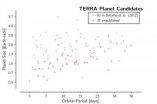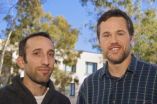(Press-News.org) An analysis of the first three years of data from NASA's Kepler mission, which already has discovered thousands of potential exoplanets, contains good news for those searching for habitable worlds outside our solar system.
It shows that 17 percent of all sun-like stars have planets one to two times the diameter of Earth orbiting close to their host stars, according to a team of astronomers from the University of California, Berkeley, and the University of Hawaii at Manoa.
This estimate includes only planets that circle their stars within a distance of about one-quarter of Earth's orbital radius – well within the orbit of Mercury – that is the current limit of Kepler's detection capability. Further evidence suggests that the fraction of stars having planets the size of Earth or slightly bigger orbiting within Earth-like orbits may amount to 50 percent.
The team – UC Berkeley graduate student Erik Petigura, former UC Berkeley post-doctoral fellow Andrew Howard, now on the faculty of the Institute for Astronomy at the University of Hawaii, and UC Berkeley professor of astronomy Geoff Marcy – will report their findings on Tuesday, Jan. 8, at a session on the Kepler mission during the American Astronomical Society meeting in Long Beach, Calif.
"Our key result is that the frequency of planets increases as you go to smaller sizes, but it doesn't increase all the way to Earth-size planets – it stays at a constant level below twice the diameter of Earth," Howard said.
Planets one to two times the size of Earth are not necessarily habitable. Painstaking observations by Petigura's team show that planets two or three times the diameter of Earth are typically like Uranus and Neptune, which have a rocky core surrounded by helium and hydrogen gases and perhaps water. Planets close to the star may even be water worlds – planets with oceans hundreds of miles deep above a rocky core.
Nevertheless, planets between one and two times the diameter of Earth may well be rocky and, if located within the Goldilocks zone – not too hot, not too cold, just right for liquid water – could support life.
"Kepler's one goal is to answer a question that people have been asking since the days of Aristotle: What fraction of stars like the sun have an Earth-like planet?" Howard said. "We're not there yet, but Kepler has found enough planets that we can make statistical estimates."
The estimates are based on a better understanding of the percentage of big Earth-size planets that Kepler misses because of uncertainties in detection, which the team estimates to be about one in four, or 25 percent.
To find planets, the Kepler telescope captures repeated images of 150,000 stars in a region of the sky in the constellation Cygnus. The data are analyzed by computer software – the "pipeline" – in search of stars that dim briefly as a result of a planet passing in front, called a transit. For planets as large as Jupiter, the star may dim by 1 percent, or one part in 100, which is easily detectable. A planet as small as Earth, however, dims the star by one part in 10,000, which is likely to be lost in the noise, Petigura said.
Petigura spent the past two years writing a software program called TERRA, for Transiting Exoearth Robust Reduction Algorithm, which is very similar to Kepler's pipeline. The UC Berkeley/Hawaii team then fed TERRA simulated planets to test how efficiently the software detects Earth-size planets.
"It may seem crazy to spend two years redoing what the Kepler team has already done, but the question we are asking – How many Earth-size planets are we missing? – is so important that we wanted to do it separately for cross-validation," he said.
"Erik is really brilliant," said Marcy, who was Petigura's research mentor when he was still a UC Berkeley undergraduate student. "He has single handedly written data analysis software from scratch, drawing upon the NASA Kepler team's expertise with its pipeline. The more people working on this, the more independent analyses, the better."
After carefully measuring the fraction of planets missed by TERRA, the team corrected for this and conducted a thorough analysis of 12 of the 13 quarters of Kepler observations freely available on the Internet. They identified 119 Earth-like planets ranging in size from nearly six times the diameter of Earth to the diameter of Mars. Thirty-seven of these planets were not identified in previous Kepler reports.
The analysis confirmed that the frequency of planets increases as the size decreases, which Howard and the Kepler team reported last year. Perhaps 1 percent of stars have planets the size of Jupiter, while 10 percent have planets the size of Neptune. Marcy compared this to rocks on a beach – large boulders are rare, stones are more common, and pebbles extremely abundant.
Unlike the beach, where sand grains and flecks are even more abundant, Petigura's team now estimates that the abundance of planets stops rising at about twice Earth's diameter and remains the same until the size of Earth, the limit of their analysis. This corrects an impression left by Howard's earlier paper that the frequency of Earth-size planets actually decreases below twice Earth's diameter.
"A year ago, Kepler had found only a few planets smaller than twice Earth's diameter, far fewer than would be expected if you extrapolate downward from the abundances of larger planets," Petigura said. Accounting for planets that Kepler misses still means that "big Earths" are one third as abundant as would be expected if the rising trend continued below twice the diameter of Earth.
Howard noted, however, that if 17 percent of all stars have Earth-size planets within the orbit of Mercury, "where are they in our solar system? Maybe our solar system is an anomaly compared to the great variety of stars."
INFORMATION:
Petigura's work was supported by a National Science Foundation graduate student fellowship.
Earth-size planets common in galaxy
Perhaps 17 percent of sun-like stars have Earth-size planets within the orbit of Mercury
2013-01-09
ELSE PRESS RELEASES FROM THIS DATE:
'Tricorder' invention could put medical diagnosis and terrorism prevention in the palm of the hand
2013-01-09
COLUMBIA, Mo. -- The hand-held scanners, or tricorders, of the Star Trek movies and television series are one step closer to reality now that a University of Missouri engineering team has invented a compact source of X-rays and other forms of radiation. The radiation source, which is the size of a stick of gum, could be used to create inexpensive and portable X-ray scanners for use by doctors, as well as to fight terrorism and aid exploration on this planet and others.
"Currently, X-ray machines are huge and require tremendous amounts of electricity," said Scott Kovaleski, ...
'Universal' personality traits may not be universal after all
2013-01-09
(Santa Barbara, Calif.) –– For decades, consensus among psychologists has held that a group of five personality traits –– or slight variations of these five –– are a universal feature of human psychology. However, a study by anthropologists at UC Santa Barbara raises doubt about the veracity of that five-factor model (FFM) of personality structure as it relates to indigenous populations. Their findings appear in the current issue of the American Psychological Association's Journal of Personality and Social Psychology.
Studying the Tsimane, an isolated indigenous group ...
Counting the twists in a helical light beam
2013-01-09
Cambridge, Mass. - January 8, 2013 - At a time when communication networks are scrambling for ways to transmit more data over limited bandwidth, a type of twisted light wave is gaining new attention. Called an optical vortex or vortex beam, this complex beam resembles a corkscrew, with waves that rotate as they travel.
Now, applied physicists at the Harvard School of Engineering and Applied Sciences (SEAS) have created a new device that enables a conventional optical detector (which would normally only measure the light's intensity) to pick up on that rotation.
The ...
New marker of drug response may speed pace of lung cancer prevention trials
2013-01-09
Testing medicines to prevent lung cancer requires treating many thousands of high-risk individuals and then waiting 5, 10 or 15 years to discover which of them develop cancer and which, if any, experience survival benefit from the treatment. A University of Colorado Cancer Center study recently published in the journal Cancer Prevention Research proposes a possible waypoint on the way to benefit, which if validated, could dramatically reduce the number of patients needed and time required to test drugs for lung cancer prevention.
"Chemoprevention is an important approach ...
Battle of the sexes: Who wins (or loses) in ACL ruptures?
2013-01-09
ROSEMONT, Ill.—Female athletes are three times more likely to suffer from anterior cruciate ligament (ACL) ruptures, one of the most common knee injuries, compared to male athletes. The ACL is one of the four main ligaments within the knee that connect the femur (upper leg bone) to the tibia (lower leg bone). Recent research highlights the unique anatomical differences in the female knee that may contribute to higher injury rates, and should be taken into consideration during reconstructive surgery and sports training, according to a review article in the January 2013 issue ...
Chemists devise inexpensive, benchtop method for marking and selecting cells
2013-01-09
LA JOLLA, CA – January 8, 2013 - Chemists at The Scripps Research Institute (TSRI) have found an easier way to perform one of the most fundamental tasks in molecular biology. Their new method allows scientists to add a marker to certain cells, so that these cells may be easily located and/or selected out from a larger cell population.
The technique, which is described in a recent issue of the chemistry journal Angewandte Chemie International Edition, makes use of the tight binding of two proteins that are cheaply obtainable but are not found in human or other mammalian ...
Pythons, lionfish and now willow invade Florida's waterways
2013-01-09
Foreign invaders such as pythons and lionfish are not the only threats to Florida's natural habitat. The native Carolina Willow is also starting to strangle portions of the St. Johns River.
Biologists at the University of Central Florida recently completed a study that shows this slender tree once used by Native Americans for medicinal purposes, may be thriving because of water-management projects initiated in the 1950s. Canals were built to control runoff and provide water for agriculture. The unintended consequence -- stable water levels -- allowed Carolina Willow ...
Obesity drops among children enrolled in NY state WIC nutrition program
2013-01-09
New York children participating in a federal nutrition program had healthier eating behaviors and lower rates of obesity two years after improvements to the program were undertaken, according to a study published online today in Obesity, the official journal of the Obesity Society.
In 2009 all 50 states rolled out sweeping changes to the menu of foods available through the Special Supplemental Nutrition Program for Women, Infants, and Children, or WIC, which reaches nearly half of all infants born in the United States. New York was the first state in the nation to roll ...
Inside DayGlo: A video tour of the world's most colorful factory
2013-01-09
A new American Chemical Society (ACS) video provides a behind-the-scenes-look at the DayGlo Color Corp. factory, producer of the fluorescent paints that light up traffic cones, black light posters, hula-hoops and other products. The video, the latest episode of the award-winning Bytesize Science series from the world's largest scientific society, is at www.BytesizeScience.com.
Inside DayGlo opens with a brief history of the company, which has been designated as an ACS National Historic Chemical Landmark, and continues with an in-depth look inside its main production ...
Testing Einstein's E=mc2 in outer space
2013-01-09
With the first explosions of atomic bombs, the world became witness to one of the most important and consequential principles in physics: Energy and mass, fundamentally speaking, are the same thing and can, in fact, be converted into each other.
This was first demonstrated by Albert Einstein's Theory of Special Relativity and famously expressed in his iconic equation, E=mc2, where E stands for energy, m for mass and c for the speed of light (squared).
Although physicists have since validated Einstein's equation in countless experiments and calculations, and many technologies ...
LAST 30 PRESS RELEASES:
Scalable and healable gradient textiles for multi‑scenario radiative cooling via bicomponent blow spinning
Research shows informed traders never let a good climate crisis go to waste
Intelligent XGBoost framework enhances asphalt pavement skid resistance assessment
Dual-function biomaterials for postoperative osteosarcoma: Tumor suppression and bone regeneration
New framework reveals where transport emissions concentrate in Singapore
NTP-enhanced lattice oxygen activation in Ce-Co catalysts for low-temperature soot combustion
Synergistic interface engineering in Cu-Zn-Ce catalysts for efficient CO2 hydrogenation to methanol
COVID-19 leaves a lasting mark on the human brain
Scientists use ultrasound to soften and treat cancer tumors without damaging healthy tissue
Community swimming program for Black youth boosts skills, sense of belonging, study finds
Specific depressive symptoms in midlife linked to increased dementia risk
An ‘illuminating’ design sheds light on cholesterol
Who is more likely to get long COVID?
Study showcases resilience and rapid growth of “living rocks”
Naval Research Lab diver earns Office of Naval Research 2025 Sailor of the Year
New Mayo-led study establishes practical definition for rapidly progressive dementia
Fossil fuel industry’s “climate false solutions” reinforce its power and aggravate environmental injustice
Researchers reveal bias in a widely used measure of algorithm performance
Alcohol causes cancer. A study from IOCB Prague confirms damage to DNA and shows how cells defend against it
Hidden viruses in wastewater treatment may shape public health risks, study finds
Unlock the power of nature: how biomass can transform climate mitigation
Biochar reshapes hidden soil microbes that capture carbon dioxide in farmland
Reducing saturated fat intake shows mortality benefit, but only in high-risk individuals
Manta rays create mobile ecosystems, study finds
Study: Mixed results in using lipoic acid to treat progressive multiple sclerosis
Norbert Holtkamp appointed director of Fermi National Accelerator Laboratory
New agentic AI platform accelerates advanced optics design
Biologists discover neurons use physical signals — not electricity — to stabilize communication
Researchers discover that a hormone can access the brain by hitchhiking
University of Oklahoma researcher awarded funding to pursue AI-powered material design
[Press-News.org] Earth-size planets common in galaxyPerhaps 17 percent of sun-like stars have Earth-size planets within the orbit of Mercury



